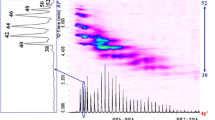Abstract
The lipid class compositions of adult Pacific oysters [Crassostrea gigas (Thunberg)] were examined using latroscan thin-layer chromatography/flame-ionization detection (TLC/FID), and fatty acid compositions determined by capillary gas chromatography and gas chromatography/mass spectrometry (GC/MS). The fatty acid methyl esters were separated using argentation TLC and also analyzed as their 4,4-dimethyloxazoline derivatives using GC/MS. Major esterified fatty acids inC. gigas were 16∶0, 20∶5n−3, and 22∶6n−3. C20 and C22 nonmethylene interrupted (NMI) fatty acids comprised 4.5 to 5.9% of the total fatty acids. The NMI trienoic fatty acid 22∶3(7,13,16) was also identified. Very little difference was found in the proportions of the various lipid classes, fatty acids or sterols between samples of adult oysters of two different sizes. However, significant differences in some of the lipid components were evident according to the method of sample preparation used prior to lipid extraction with solvents. Lyophilization (freeze drying) of samples led to a significant reduction in the amounts of triacylglycerols (TG) extracted by solvents in two separate experiments (7.0 and 52.5% extracted). Extracts from lyophilized samples had less 16∶0, C18 unsaturated fatty acids, and 24-ethylcholest-5-en-3β-ol, while C20 and C22 unsaturated fatty acids comprised a higher proportion of the total fatty acids. There was no significant change in the amounts of polar lipids, total sterols, free fatty acids or hydrocarbons observed in extracts from lyophilized samples relative to extracts from nonlyophilized samples. Addition of water to the freezedried samples prior to lipid extraction greatly improved lipid yields and resulted in most of the TG being extracted.
Similar content being viewed by others
Abbreviations
- DG:
-
diacylglycerols
- DMDS:
-
dimethyldisulfide
- DMOX:
-
4,4-dimethyloxazoline
- FAME:
-
fatty acid methyl esters
- FFA:
-
free fatty acids
- FID:
-
flame-ionization detector
- GC:
-
gas chromatography
- GC/MS:
-
gas chromatography/mass spectrometry
- NMI:
-
nonmethylene interrupted
- NMID:
-
nonmethylene interrupted dienoic fatty acid
- NMIT:
-
nonmethylene interrupted trienoic fatty acid
- PL:
-
polar lipids
- PUFA:
-
polyunsaturated (polyenoic) fatty acids
- TG:
-
triacylglycerols
- TLC:
-
thin-layer chromatography
- TLC/FID:
-
thin-layer chromatography/flame-ionization detection
- TMTD:
-
trimethyltridecanoic acid
- WE:
-
was esters
References
Trider, D.J., and Castell, J.D. (1980)J. Nutr. 110, 1303–1309.
Langdon, C.J., and Waldock, M.J. (1981)J. Mar. Biol. Assoc. U.K. 61, 431–448.
Enright, C.T., Newkirk, G.F., Craigie, J.S., and Castell, J.D. (1986)J. Exp. Mar. Biol. Ecol. 96, 1–13.
Helm, M.M., Holland, D.L., and Stephenson, R.R. (1973)J. Mar. Biol. Ass. UK 53, 673–684.
Gallager, S.M., Mann, R., and Sasaki, G.C. (1986)Aquaculture 56, 81–103.
Trider, D.J., and Castell, J.D. (1980)Proc. National Shellfisheries Ass. 70, 112–118.
Ruiz, C., Martinez, D., Mosquera, G., Abad, M., and Sánchez, J.L. (1992)Mar. Biol. 112, 67–74.
Watanabe, T., and Ackman, R.G. (1974)J. Fish. Res. Bd. Can. 31, 403–409.
Waldock, M.J., and Nascimento, I.A. (1979)Mar. Biol. Letters 1, 77–86.
Bligh, E.G., and Dyer, W.J. (1959)Can. J. Biochem. Physiol. 37, 912–917.
Peuchant, E., Wolff, R., Salles, C., and Jensen, R. (1989)Anal. Biochem. 181, 341–344.
Cabrini, L., Landi, L., Stefanelli, C., Barzanti, V., and Sechi, A.-M. (1992)Comp. Biochem. Physiol. 101B, 383–386.
Guckert, J.B., Cooksey, K.E., and Jackson, L.L. (1988)J. Microbiological Met. 8, 139–149.
Nelson, G.J. (1975) inAnalysis of Lipids and Lipoproteins. (Perkins, E.G., ed.) pp. 1–22, American Oil Chemists' Society, Champaign.
Christie, W.W. (1982)Lipid Analysis, 2nd edn., p. 207, Pergamon Press, Oxford.
van Sumere, C., Geiger, H., Bral D., Fockenier, G., van de Casteele, K., Martenus, M., Haselaer, R., and Gevaert, L. (1983)Anal. Biochem. 131, 530–532.
van de Meent, D., Maters, W.L., de Leeuw, J.W., and Schenck, P.A. (1977)Org. Geochem. 1, 7–9.
Holland, D.L., and Gabbott, P.A. (1971)J. Mar. Biol. Ass. UK 51, 659–668.
Holland, D.L., and Hannant, P.J. (1973)J. Mar. Biol. Ass. UK 53, 833–838.
Whyte, J.N.C., Bourne, N., and Hodgson, C.A. (1987)J. Exp. Mar. Biol. Ecol. 113, 113–124.
Fay, L., and Richli, U. (1991)J. Chromatogr. 541, 89–98.
Hopkins, C.C.E., Siering, J.V., Nyholmen, O., and Hermannsen, A. (1984)Oceanogr. Mar. Biol. Ann. Rev. 22, 211–261.
Volkman, J.K., Everitt, D.A., and Allen, D.I. (1986)J. Chromatogr. 356, 147–162.
Nichols, P.D., Guckert, J.B., and White, D.C. (1986)J. Microbiol. Methods 5, 49–55.
Dudley, P.A., and Anderson, R.E. (1975)Lipids 10, 113–114.
Mann, R., and Gallager, S.M. (1985)J. Exp. Mar. Biol. Ecol. 85, 211–228.
Farrington, J.W., Davis, A.C., Frew, N.M., and Knap, A. (1988)Mar. Poll. Bull. 19, 372–380.
Joseph, J.D. (1989) inMarine Biogenic Lipids, Fats and Oils (Ackman, R.G., ed.) Vol. 2, pp. 49–144, CRC Press, Boca Raton.
Chu, F.-L.E., Webb, K.L., and Chen, J. (1990)Comp. Biochem. Physiol. 95A, 385–391.
Ackman, R.G. (1982) inProc. Second Int. Conf. Aquaculture Nutrit. (Pruder, G.D., Langdon, C.J., and Conklin, D.E., eds.) pp. 358–376, World Mariculture Society Special Publication No. 2, Baton Rouge.
Whyte, J.N.C. (1988)Aquaculture 75, 193–203.
Ackman, R.G. (1989) inMarine Biogenic Lipids, Fats and Oils (Ackman, R.G., ed.) Vol. 1, pp. 103–138, CRC Press, Boca Raton.
Henderson, R.J., and Almatar, S.M. (1989)J. Mar. Biol. Ass. UK 69, 323–334.
Author information
Authors and Affiliations
About this article
Cite this article
Dunstan, G.A., Volkman, J.K. & Barrett, S.M. The effect of lyophilization on the solvent extraction of lipid classes, fatty acids and sterols from the oysterCrassostrea gigas . Lipids 28, 937–944 (1993). https://doi.org/10.1007/BF02537504
Issue Date:
DOI: https://doi.org/10.1007/BF02537504




